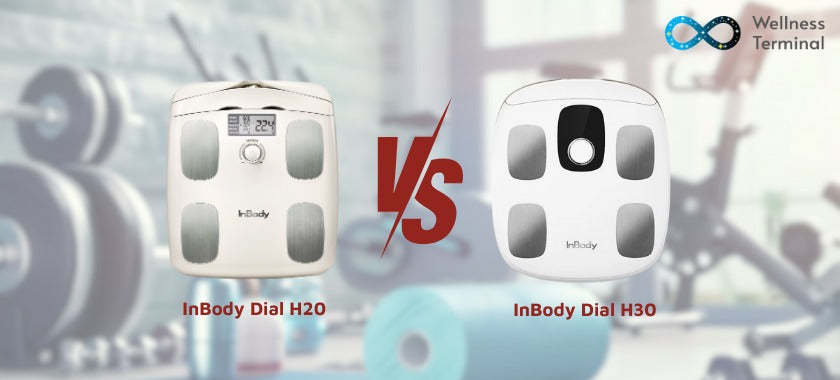In the world of health and fitness, tracking your body composition is a game-changer. Gone are the days when weight alone was the key indicator of health. Today, body composition scales like the InBody H20N and H30 give you a deeper understanding of what you're made of, helping you make informed decisions about your fitness journey.
But with two excellent choices on the market in 2025, how do you select the right one? In this article, we’ll explore the features of the InBody H20N Vs. H30 body fat scales, examine the technology behind them and provide a detailed comparison to help you decide which one fits your needs.
What is Body Composition Analysis and Why is it Important?
Body composition analysis is the process of breaking down your body into its core components: fat, muscle, water, and bones. Unlike traditional scales that only measure your total body weight, body composition scales help you understand how much of that weight comes from fat versus muscle or other components.
This data is crucial because health isn’t just about your weight. Two people might weigh the same but have vastly different health profiles due to variations in fat and muscle.
A higher muscle mass percentage can indicate better overall fitness, while higher fat percentages might signal a need for lifestyle changes.
Body composition analysis can help track changes in muscle mass, fat loss, and hydration, giving you a comprehensive picture of your health progress.
InBody Technology: How It Stands Out
InBody is a leading brand in body composition analysis, and its technology sets it apart from traditional scales. InBody devices use Bioelectrical Impedance Analysis (BIA) to measure body composition accurately.
The key differentiator in InBody technology is its ability to provide segmental analysis—offering detailed readings for each part of your body, such as your arms, legs, and torso. This segmentation allows you to track muscle and fat changes more precisely in specific areas.
Additionally, InBody scales don't rely on empirical estimations like many other brands, meaning they don't require assumptions based on age or gender. Instead, they rely purely on your body’s actual measurements, making the data more accurate and personalized.
The Wi-Fi connectivity, app integration, and easy-to-read displays also enhance user experience, making these devices a top choice for home users and fitness enthusiasts.
InBody H20N Review and Features
The InBody H20N is the more compact and budget-friendly option in the InBody consumer range. This scale is perfect for those new to body composition and fitness tracking or those who want a straightforward way to monitor their health.

Key Features:
- Body Composition Analysis: Tracks body fat percentage, muscle mass, and BMI, among other metrics.
- User-Friendliness: The device is easy to use, with a simple setup and clear readings.
- Portable Design: Its lightweight and compact design makes it easy to store and move around, making it ideal for home use.
- Mobile App Integration: The InBody App syncs seamlessly with the device, allowing you to track and compare your data over time.
- Cost-Effective: The H20N is the more affordable option, making it accessible to a wider range of users.
Pros:
- Affordable pricing
- Compact and easy to use
- Provides accurate and essential body composition data
Cons:
- Limited features compared to the H30
- No segmental body analysis
InBody Dial H30 Review and Features
The InBody Dial H30 is the more advanced version in this lineup, offering additional features and more in-depth body composition analysis. It's designed for those who want a comprehensive health and fitness tool to take their measurements to the next level.
Key Features:
- Segmental Body Composition: Tracks muscle and fat in specific body areas, allowing for more targeted fitness plans.
- Advanced Metrics: In addition to the basic metrics of body fat, muscle mass, and BMI, the H30 also provides more detailed data on visceral fat and basal metabolic rate (BMR).
- Wi-Fi Connectivity: Allows you to store and access your data on the InBody app, providing trends and detailed graphs to track progress.
- Multiple User Profiles: This feature makes it a great choice for families or fitness groups who want to use the scale together.
- Durability and Precision: The H30 is built with higher durability and more precision sensors, ensuring you get consistent, accurate results over time.
Pros:
- Segmental analysis for precise body tracking
- Detailed metrics like visceral fat and BMR
- More advanced features for serious fitness enthusiasts
Cons:
- Higher price point compared to Inbody H20N
- Slightly bulkier design compared to the H20N
InBody H20N Vs. InBody H30: Comparison
While the InBody H20N vs H30 share many core features, the differences between the two are subtle rather than drastic. Both scales offer accurate body composition measurements using InBody’s advanced technology, making them highly effective for home users who want to track their fitness progress. However, there are a few key distinctions:
Metrics and Features:
- Inbody H20N: Provides essential measurements such as body fat percentage, muscle mass, and BMI, along with a user-friendly interface.
- Inbody Dial H30: Offers the same core metrics but also includes more advanced options like basal metabolic rate (BMR) and the ability to provide segmental body composition analysis.
Design and User Profiles:
- Inbody H20N: Slightly more compact and lightweight, making it ideal for personal use.
- Inbody Dial H30: Built with slightly more robust sensors and offers the ability to track multiple user profiles, making it more suitable for shared households.
User Profiles:
- Inbody H20N: Better suited for individual use or small households.
- Inbody Dial H30: Supports multiple user profiles, making it suitable for families or shared spaces.
Price:
- Inbody H20N: Slightly more affordable, appealing to those who want reliable body composition tracking without the added features.
- Inbody Dial H30: A small price increase reflects the additional capabilities for more detailed analysis.
| InBody H20 Vs. H30 Comparison | H20 | H30 |
| Weight | ✔ | ✔ |
| Skeletal Muscle Mass | ✔ | ✔ |
| Fat Mass | ✔ | ✔ |
| BMI | ✔ | ✔ |
| Percent Body Fat | ✔ | ✔ |
| Abdominal Fat Percentage | ✔ | ✔ |
| Visceral Fat Level | ✘ | ✔ |
| Soft Lean Mass | ✔ | ✔ |
| InBody Score | ✘ | ✔ |
| Body Type | ✔ | ✔ |
| Balance | ✘ | ✔ |
| Basal Metabolic Rate | ✔ | ✔ |
| Height: Age and My Position | ✘ | ✔ |
| Weight: Age and My Position | ✘ | ✔ |
InBody H20N Vs. InBody H30: Conclusion
Ultimately, the decision between the InBody H20N Vs H30 depends on your fitness goals, budget, and how in-depth you want your body composition analysis to be.
If you're new to body composition analysis or want a budget-friendly option, the InBody H20N offers precise, essential data and easy usability, helping you track your fitness goals effectively.
For fitness enthusiasts or those seeking deeper insights, the InBody H30 is a smart investment. Its advanced metrics, segmental analysis, and multi-user profiles provide comprehensive tracking for long-term progress.


